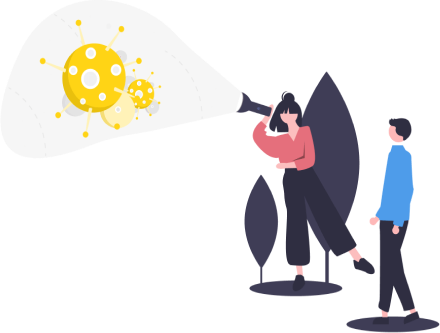
HPV stands for human papillomavirus. 80-90% of people become infected with it at some point in their life. Normally, the infection resolves on its own within two years, but not always. 1
When the body fails to clear the HPV infection, this can lead to developing cancer in the following areas:
These cancers typically occur later in life, but cervical cancer can affect women as early as 30-35 years old. Certain types of HPV can also cause genital warts or warts on the vocal cords and airways, known as laryngeal and tracheal papillomas. 1.2

80-90% of people will deal with an HPV infection at some point in their life.1
Over 170 types of HPV are known. Some of them can cause cancer or genital warts.2
HPV usually spreads through sexual contact, including
vaginal, anal, or oral sex, but also through skin-to-skin
contact during sex. The virus is highly contagious, and
even sharing a towel with an infected person can lead to
contracting genital warts. 1-3
Everyone can get infected with the virus, but certain groups have a higher risk of developing HPV-related diseases.2,4,5 This includes, for example:
60% chance that you will be infected with the HPV virus during sex with an infected person.2

Condoms do not fully protect against HPV infection.1
In most cases, you don’t notice an infection with HPV and your body clears up the virus on its own. If this does not happen, an HPV infection can lead to developing
cancer or warts. The initial symptoms may include 1,2:
Around 1100 women and near 400 men develop HPV- related cancer each year in the Netherlands. Approximately 400 of them die.6
In 2021, over 18,500 women and nearly 29,000 men in the Netherlands were diagnosed with genital warts.3
There are three ways to protect yourself against the consequences of HPV1:
HPV-vaccines are around 90% effective against infections with the HPV-types they target.1
1. RIVM, HPV , accessed aug 2023
2. Gezondheidsraad, HPV vaccinatie tegen HPV , accessed jun 2019
3. RIVM, Genitale wratten , accessed aug 2023
4. LCI, Richtlijn HPV vaccinatie , accessed aug 2023
5. Kanker.nl, HPV en baarmoederhalskanker, accessed aug 2023
6. RIVM, HPV: feiten en cijfers, accessed aug 2023
Visit the FAQ page and find answers to your HPV-related questions